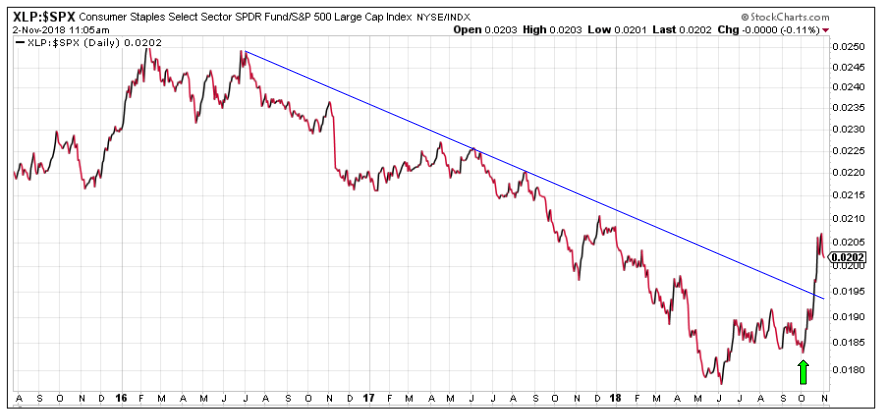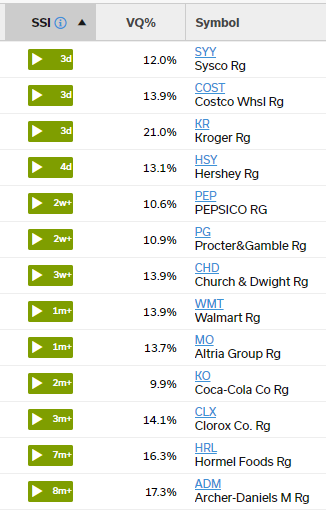It’s turbulent out there. October was one of the worst months in years for U.S. equities and the worst October for corporate bonds since the financial crisis of 2008.
Corporate earnings reports for S&P 500 names have been strong — on track for the best percentage earnings growth since 2010, according to research firm Refinitiv — and yet the post-earnings price change for the typical S&P 500 stock has been negative rather than positive.
In simple terms, S&P 500 companies are reporting strong earnings growth on balance, but investors are selling the news rather than buying. This shows concern for the future earnings outlook.
But there is always a bull market somewhere. As investors turn defensive, they are piling into consumer staples stocks. If anxiety continues to build over the length of this aging bull market and the health of the U.S. economy — and maybe even if it doesn’t — consumer staples could see a bullish trend from here.
First, let’s quickly review the damage. On Sept. 20, the S&P 500 was up 9.62% — the high-water mark for the year thus far. The month of October saw all of those gains wiped out. A rebound into November erased some of the damage, but nowhere close to all.
Up until late September, roughly half the gains of the S&P 500 had come from just five companies: Apple, Amazon, Microsoft, Netflix, and Alphabet (the parent company of Google). All of those high flyers saw heavy selling in October, the mighty Amazon selling off hard in particular.
Between Oct. 1 and Nov. 1, Amazon (Nasdaq: AMZN) fell nearly 17%, with a decline of more than 24% at the lowest point. And yet, even with a 17% drop, as of Nov. 1 AMZN was still up more than 40% year-to-date. Netflix also fell nearly 17% over the October 2018 timeframe, but was up more than 65% on the year as of Nov. 1. Adding insult to injury, tech bellwether Apple (Nasdaq: AAPL) is joining the heavy decliners as of this writing (due to a poorly received earnings report).
And it wasn’t just the “crowded trade” tech names that hurt the market in October. Blue chip stalwarts like Dow DuPont, Home Depot, and Mastercard all fell by double-digit percentages on the month, with Dow DuPont down nearly 20% at its worst.
Financials also took a nasty October hit, with the S&P money center and regional bank ETFs falling 13% at one point. And then there was trade war and tariff fallout: Global construction bellwether Caterpillar (NYSE: CAT), at its worst, was down 25%.
In light of all this carnage, the performance of consumer staples was a breath of fresh air. You can see this via the spread between XLP, the SPDR Consumer Staples ETF, and the S&P 500 as shown below. For nearly three years, XLP underperformed relative to the S&P. The surge higher, which began in October, shows the near-vertical acceleration of XLP outperformance.
 |
Consumer staples stocks are historically a “defensive” investment play. They tend to outperform when investors are fearful or concerned. At this moment in time there is plenty to be concerned about — from rising interest rates and labor costs, to trade war fears and political uncertainty, plus historically high equity valuations to boot.
These negatives could fuel a new bullish trend for consumer staples, which serve as a kind of shoebox for investor capital when the environment gets tough. A good number of Wall Street money managers are required to be 100% invested or close to 100% invested, even when they would rather be in cash; for these managers, consumer staples (and sometimes utilities) can be the next best thing to cash.
XLP, the SPDR Consumer Staples ETF, contains a number of recently strong performers like Procter & Gamble (NYSE: PG), Walmart (NYSE: WMT), and Philip Morris (NYSE: PM). But XLP also contains more than a few laggards; not all consumer staples names are equal in 2018. Below you will find a select group of strong consumer staples plays that you can find in TradeStops, sorted by the amount of time each has spent in the Stock State Indicator green zone.
 |
The historic bull run for U.S. equities, almost a decade old now, may not be over yet. But even if it resumes in quick fashion, consumer staples could see more inflows as investors grow cautious. And given the recent headline drama, it would be no surprise to find “boring is beautiful” for a while.





